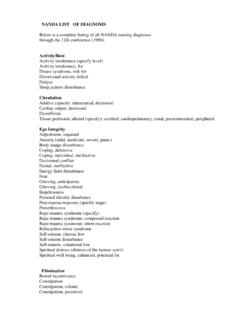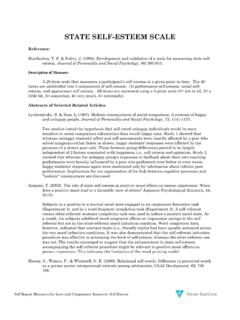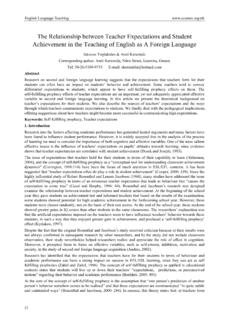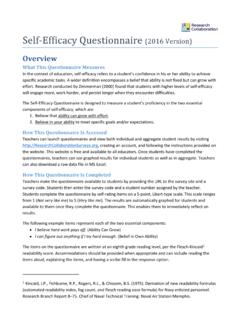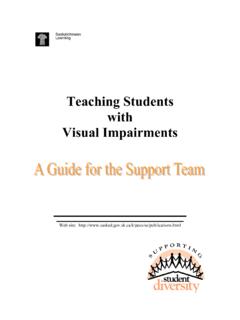Transcription of Barriers to Participation in Youth Sports - ed
1 Barriers to Participation of Children with Disabilities in Youth Sports Thomas E. Moran Martin E. Block A Feature Article Published in TEACHING Exceptional Children Plus Volume 6, Issue 3, February 2010. Copyright 2009 by the author. This work is licensed to the public under the Creative Commons Attri- bution License Barriers to Participation of Children with Disabilities in Youth Sports Thomas E. Moran Marin E. Block Abstract Youth Sports were created as opportunities for children to play, be active, and begin learning how to become better or more successful at a given sport. Unfortunately many children with disabili- ties may not get the same opportunities that are available to other children.
2 There are a number of Barriers that inhibit children with significant disabilities from either participating in the Youth sport programming all together or have a strong impact their level of successful Participation . This article both identifies key Barriers as well as provides strategies to eliminate or minimize the impact of the given barrier. This problem-solution approach is meant to help to focus our atten- tion on the root of the problem and begin using some practical strategies that will help better serve and provide opportunities for children with disabilities to help them get into the game . Keywords Disability, Youth Sports , children with disabilities, disability sport, sport Participation , Barriers , community based Sports , training, parents, coaches SUGGESTED CITATION: Moran, , & Block, (2010).
3 Barriers to Participation of Children with Disabilities in Youth Sports TEACHING Exceptional Children Plus, 6(3) Article 5. Retrieved [date] from 2. For many parents and children, Satur- with disabilities as it is for children without days are set aside for Youth soccer, baseball, disabilities. Unfortunately, many children with football, and other Youth Sports . Children as disabilities, particularly children with more young as 5-years-old proudly show off their significant disabilities such as physical, visual team uniforms around the community, and or intellectual disabilities or autism are ex- new friendships between players often lead to cluded from Participation in Youth Sports .
4 In pick-up-games in the backyard, parties, and some cases leaders of Sports programs may be team sleep overs. For many children the best concerned with the liability of having a child part of the week is practice with their friends, with a disability participate in and perhaps get and the best part of the weekend is getting hurt during a practice or game. In other cases into their uniform and competing with their coaches may not want a child with a disability teammates. For many parents, nothing is on their team, because they feel that they lack more exciting and nerve-racking than watch- the training in how to coach players with dis- ing their child play in a game.
5 Abilities. In still other cases parents of children Research supports positive effects of with disabilities (and children themselves). Youth Sports on young athletes. Seefeldt, Ew- may be reluctant to sign up for Youth Sports ing, and Walk (1992) summarized much of fearing injury, lack of success, or being teased the research finding several benefits associ- by peers. Finally, there may be limited Sports ated with Participation in Youth Sports includ- programs (regular or special Sports programs). ing: (a) improved Sports skills such as learn- available to serve the wide range of types and ing how to correctly kick a soccer ball, throw severities of disabilities.
6 Exclusion from Youth a baseball, or dribble a basketball (The Sports programs is unfortunate as the Ameri- Tucker Center for Research on Girls & cans with Disabilities Act (ADA) specifically Women in Sport, 2007); (b) improved physi- forbids public and private programs (including cal fitness including a greater understanding community Youth Sports programs) from ex- of and interest in getting into and staying in shape (Ewing & Seefeldt; 1989; US Depart- ment of Health and Human Services, 2008); Children with disabilities may (c) improved self - esteem and self -confidence be reluctant to sign up for Youth (see Malina & Cumming, 2003, for a review); Sports fearing injury, lack of suc- (d) making new friends and having a sense of cess or being teased by peers.
7 Belonging (see Weiss & Stuntz, 2004, for a review), (e) moral development including cluding individuals with disabilities from such concepts such as fair play and sportsmanship programs solely on the basis of their disability ( , Bredemeier, Weiss, Shields, & Shew- (Appenzeller, 2005; Block, 1995; Stein, chuk, 1986; Gibbins, Ebbeck, & Weiss, 2005). In addition, most Youth Sports pro- 1995), and (f) learning how to manage one's grams can be adapted to accommodate the time, how to set goals, and how stay in con- needs of children with significant disabilities trol (Dworkin, Larson, & Hansen, 2003). through universal design (Lieberman &.)
8 Positive effects of Participation in Houston-Wilson, 2009) and game modifica- Youth Sports can be as powerful for children tions (Block, 2007; Kasser & Lytle, 2005;. 3. Lieberman & Houston-Wilson, 2009). In fact, posts were more dangerous than their child's research shows Youth Sports programs can be walker, and his parents eventually took the accommodated to include children with dis- league to court to force the league to let Ryan abilities (Bernabe & Block, 1994; Nixon, play. The District judge agreed with the 1989), and Youth Sports coaches are generally parents finding it very unlikely another player willing to include children with disabilities on would get injured from the walker.
9 As a result, their teams (Block & Malloy, 1999; Rizzo, the child was allowed to finish the season with Bishop, & Silva, 1999; Rizzo, Bishop, & To- his team (Boyd, 1999). bar, 1997) Regrettably, despite laws and re- search there continue to be many Barriers that Solution prevent Youth with significant disabilities As in many cases where people with from participating in Youth Sports . The pur- disabilities are summarily dismissed from par- pose of this article is to review some of these ticipation, education is the key to changing more common Barriers to Participation of league administrators' preconceived opinions children with significant disabilities in Youth and attitudes.
10 Parents of a child with a disabil- Sports with suggestions for how to overcome ity are the best advocates for their child, and these Barriers . they can begin the education process with Barrier #1: Leader of Programs Fear league officials. For example, Ryan's parents Liability/Do not know how to Accommodate did try and explain to the league president how they could pad Ryan's walker to prevent Problem others from injury (although in this case it did not work). They also could explain some sim- Perhaps the greatest barrier to the par- ple modifications that could be implemented ticipation of children with disabilities in to allow Ryan and those around him to play Youth Sports is the fear of liability by program safely without negatively affecting the game leaders (Appenzeller, 2000).










